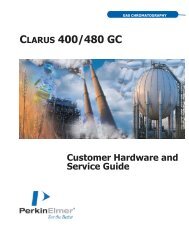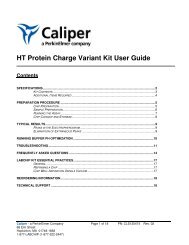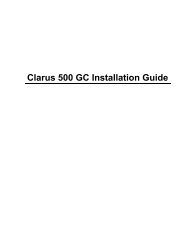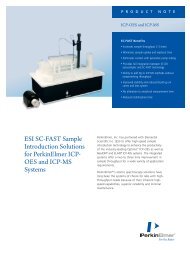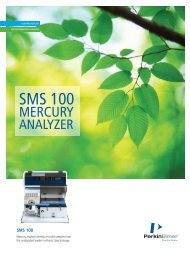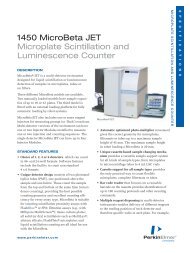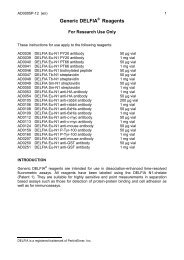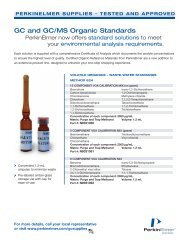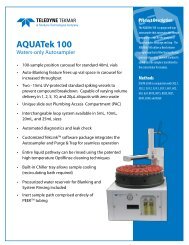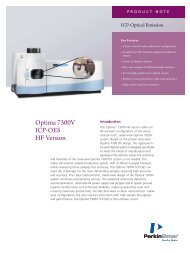EnSpire-LFC, 96 well (Cell Assay Microplate with ... - PerkinElmer
EnSpire-LFC, 96 well (Cell Assay Microplate with ... - PerkinElmer
EnSpire-LFC, 96 well (Cell Assay Microplate with ... - PerkinElmer
You also want an ePaper? Increase the reach of your titles
YUMPU automatically turns print PDFs into web optimized ePapers that Google loves.
TECHNICAL<br />
DATA SHEET<br />
Multimode Detection<br />
<strong>EnSpire</strong>-<strong>LFC</strong>, <strong>96</strong> <strong>well</strong> (<strong>Cell</strong> <strong>Assay</strong><br />
<strong>Microplate</strong> <strong>with</strong> fibronectin coating)<br />
<strong>Cell</strong>ular Label-free <strong>Microplate</strong><br />
Part numbers: 6055420, 6055428.<br />
Caution: For Laboratory Use. A research product for research purposes only.<br />
Product provided<br />
<strong>Microplate</strong>s: 2 X <strong>96</strong>-<strong>well</strong> microplates per case (6055420)<br />
8 X <strong>96</strong>-<strong>well</strong> microplates per case (6055428)<br />
Format: Individually packaged<br />
Description<br />
The <strong>EnSpire</strong> ® -<strong>LFC</strong> <strong>96</strong>-<strong>well</strong> fibronectin coated microplate is an ANSI/SBS standard microplate <strong>with</strong> a patented<br />
optical biosensor integrated into each <strong>well</strong>. It is an integral component of the <strong>EnSpire</strong> <strong>with</strong> Corning ® Epic ®<br />
label-free technology. The surface of each fibronectin coated plate enables attachment and normal growth of<br />
weakly adherent cells including native cells, recombinant / engineered cell lines and frozen cells, and primary<br />
cells. This label-free enabled microplate can only be used <strong>with</strong> the <strong>EnSpire</strong> <strong>with</strong> label free technology<br />
instrument and no other label-free platforms.
Product Information<br />
Handling<br />
Cleaning procedure<br />
Materials<br />
Plate format<br />
Plate color<br />
Well bottom<br />
Well bottom color<br />
Well shape<br />
Open no more than 1 hour before use. Avoid touching the bottom of<br />
the microplate<br />
Fingerprints can be removed using 100 % Ethanol and a Kim wipe.<br />
(Kimberly-Clark KIMWIPES ® Disposable Wipers, part number 2017)<br />
Cyclic Olefin Copolymer <strong>with</strong> Glass Bottom<br />
<strong>96</strong>-<strong>well</strong><br />
Black <strong>with</strong> clear bottom<br />
Flat<br />
Clear<br />
Round<br />
Well area 16 mm 2<br />
Maximum <strong>well</strong> volume<br />
Recommended working volume<br />
Surface treatment<br />
Tissue culture compatible<br />
Sterile<br />
Lids included<br />
Typical seeding density<br />
Barcode<br />
Regulatory status<br />
Shipping conditions<br />
Storage conditions<br />
Shelf life<br />
209 μL<br />
50-100 μL<br />
Fibronectin<br />
Yes<br />
Aseptically manufactured<br />
Yes<br />
10,000 – 100,000 cells/<strong>well</strong> (cell type dependent)<br />
Yes (short right hand side)<br />
Patented Biosensor technology<br />
Ambient<br />
2 – 8 °C (do not freeze)<br />
Minimum 3 months from shipment date when stored correctly<br />
Quality Control<br />
Each <strong>well</strong> is factory tested for resonant wavelength<br />
Tested for ability to promote and stabilize attachment and growth of HEK-293 cells<br />
Fibronectin pre-tested and found negative for bacteria and fungi<br />
Functionally tested for assay performance<br />
Aseptically manufactured<br />
www.perkinelmer.com 2/10
Applications<br />
<strong>Assay</strong> development, primary and secondary cell-based screening, profiling<br />
GPCR pathway identification and validation<br />
Endogenous receptor modular<br />
Receptor panning<br />
Orphan receptor studies<br />
<strong>Cell</strong> proliferation studies<br />
ADME/Tox studies<br />
Ion channel assays<br />
Tyrosine kinase receptors<br />
<strong>Cell</strong> Lines<br />
HEK-293 cells<br />
Engineered CHO cells<br />
A431 cells<br />
1321N1 cells<br />
Primary cells<br />
Stem cells<br />
www.perkinelmer.com 3/10
Specifications<br />
Column Heading<br />
Column Heading<br />
Number of rows 8<br />
Number of columns 12<br />
Height<br />
Well diameter<br />
Well volume<br />
14.22 mm <strong>with</strong>out lid (15.50 mm <strong>with</strong> lid)<br />
5.00 mm at top, 4.50 mm at bottom<br />
209 μL<br />
Top left corner X = 14.38, Y = 11.24<br />
Top right corner X = 113.38, Y = 11.24<br />
Bottom left corner X = 14.38, Y = 74.24<br />
Bottom right corner X = 113.38, Y = 74.24<br />
<strong>Microplate</strong> flatness (global flatness)<br />
Biosensor position<br />
Table 1. <strong>Microplate</strong> specifications.<br />
55 μm<br />
True position of 250 μm in any direction<br />
from SBS center points<br />
www.perkinelmer.com 4/10
Figure 2. <strong>Microplate</strong> dimensions and cross section of <strong>well</strong>.<br />
www.perkinelmer.com 5/10
Example <strong>Assay</strong><br />
Standard <strong>Cell</strong>-Based <strong>Assay</strong> <strong>with</strong> <strong>PerkinElmer</strong> Human Adrenergic β2 Receptor –<br />
irradiated Frozen <strong>Cell</strong>s using <strong>EnSpire</strong>-<strong>LFC</strong>, <strong>96</strong>-<strong>well</strong> plate (<strong>Cell</strong> assay microplate <strong>with</strong><br />
fibronectin coating)<br />
This protocol describes how to perform an <strong>EnSpire</strong> label-free cell-based assay that consists of agonist<br />
addition in an <strong>EnSpire</strong>-<strong>LFC</strong>, fibronectin-coated <strong>96</strong>-<strong>well</strong> plate.<br />
Materials<br />
HBSS <strong>with</strong> Ca 2+ and Mg 2+ (Invitrogen cat# 14025-126)<br />
1M Hepes, pH 7.4 (Invitrogen cat# 15630-080)<br />
F12K Nutrient Mixture (Gibco cat# 21127)<br />
Heat-inactivated Fetal Bovine Serum (Gibco cat# 10082)<br />
Isoproterenol (Sigma cat# I6504)<br />
1 vial Human Adrenergic β2 Receptor -Irradiated Frozen <strong>Cell</strong>s (B2AR) (<strong>PerkinElmer</strong> cat# ES-034-<br />
CF)<br />
DMSO (Sigma cat# D8418)<br />
<strong>EnSpire</strong>-<strong>LFC</strong>, <strong>96</strong>-<strong>well</strong> <strong>Cell</strong> assay microplate <strong>with</strong> fibronectin coating (<strong>PerkinElmer</strong> cat# 6057420 or<br />
cat# 6055428)<br />
Tissue Culture Incubator (37°C, 5% CO 2 or as appropriate for specific cell type)<br />
Water bath, 37°C<br />
<strong>Cell</strong> counter<br />
Microscope<br />
<strong>96</strong>-<strong>well</strong> multichannel pipettor<br />
Aspiration Wand (VP Scientific cat# VP186LP), including vacuum pump source<br />
Standard Laboratory Grade Tape used to tape ends of Aspiration wand so that it leaves 35 μL<br />
residual volume in test plate (tape and test want prior to assay)<br />
<strong>96</strong>-<strong>well</strong> conical or round bottom polypropylene microplate (ThermoScientific cat# 249944 or<br />
<strong>PerkinElmer</strong> cat# 6008290)<br />
15 mL and 50 mL conical tubes<br />
Large volume seriological pipettor (5-25 mL aspirator pipet refills)<br />
Plate/cell tube centrifuge<br />
Manual pipets (10 µL-1000 µL)<br />
Multichannel pipets, <strong>96</strong>-<strong>well</strong> plate compatible (10 µL-200 µL at least manual)<br />
www.perkinelmer.com 6/10
Eppendorf tubes (1.5 mL)<br />
Foil plate seals (VWR cat# BK538619)<br />
18 M distilled, filtered water (or cell culture-grade)<br />
0.22 µM cellulose acetate filter system (1 L capacity)<br />
<strong>Cell</strong> culture hood equipped <strong>with</strong> vacuum pump source<br />
Bleach<br />
Ethanol (70% in spray bottle)<br />
Reagent reservoirs (100 mL)<br />
Glass or plastic storage bottles for making buffers (250 mL-1000 mL)<br />
Reagents Preparation (Day 1)<br />
1. Medium preparation in cell culture hood (complete media)<br />
o 500 mL F12K Nutrient Mixture<br />
o 50 mL Heat-inactivated Fetal Bovine Serum<br />
o Filter using 0.22 μm cellulose acetate filter system<br />
o Store at 4°C<br />
2. <strong>Assay</strong> buffer Preparation – make on Day 2 (HBSS/20 mM Hepes/1% DMSO)<br />
o 291 mL HBSS<br />
o 6 mL Hepes<br />
o 3 mL DMSO<br />
o Store at room temperature<br />
3. Agonist (Isoproterenol) Preparation (100 mM)<br />
o Weigh 25 mg of Isoproterenol in 1.5 mL Eppendorf tube<br />
o Add 1 mL water, vortex<br />
o Store aliquots at -20°C<br />
<strong>Cell</strong> Seeding (Day 1)<br />
1. Warm complete media to 37°C in water bath.<br />
2. Put on gloves and spray down cell culture hood <strong>with</strong> 70% ethanol (be sure that all supplies brought into<br />
the hood are sterile or sprayed <strong>with</strong> 70% ethanol).<br />
3. Take <strong>EnSpire</strong>-<strong>LFC</strong>, <strong>96</strong>-<strong>well</strong> fibronectin coated “test plate” out of package and place in hood (plate stored<br />
at 4°C, make sure it is at room temperature before use).<br />
www.perkinelmer.com 7/10
4. Using multichannel pipettor, add 40 μL complete media to columns 1-3 of test plate.<br />
5. Centrifuge plate at 800 RPM for 1 minute and place back in hood.<br />
6. Remove vial of B2AR cells from liquid nitrogen (wear gloves and eye wear).<br />
7. Hold vial of B2AR cells in 37°C water bath (do not submerge) until vial is 75% thawed.<br />
8. Spray vial <strong>with</strong> 70% ethanol and put in cell culture hood.<br />
9. Add 1 mL of complete media slowly to vial and aspirate up and down 2 times.<br />
10. Transfer all contents of vial to a 50 mL conical tube containing 8 mL complete media (total volume = 10<br />
mL).<br />
11. Centrifuge 50 mL tube of cells at 1500 RPM for 5 minutes and remove supernatant (to wash cells).<br />
12. Re-suspend pellet in 3 mL complete media and count cells.<br />
13. Need 250 cells/μL (20,000 cells/<strong>well</strong>/80 μL), or 250,000 cells/mL. 3 mL of cells is sufficient for 3 columns<br />
of a <strong>96</strong>-<strong>well</strong> plate, so need roughly 750,000 cells to plate at density of 20,000 cells/<strong>well</strong> in 3 columns of a<br />
<strong>96</strong>-<strong>well</strong> plate.<br />
14. Dilute cells appropriately (from 5 mL suspension) in complete media and pour into sterile reservoir.<br />
15. Add 80 μL of cells to columns 1-3 of test plate using multichannel pipettor (be careful not to touch bottom<br />
of test plate, but also be careful not to pipet too high to create air bubbles).<br />
16. Incubate lidded plate in hood for 30 minutes to stabilize.<br />
17. Put test plate in 37°C incubator overnight.<br />
Buffer Exchange (Day 2)<br />
1. Look at cells in plate under microscope (note degree of confluency should be 70-80%).<br />
2. Prepare aspiration wand prior to assay by taping ends so that residual volume left in plate is 35 μL.<br />
3. Media/Buffer exchange using aspiration wand (assay buffer HBSS/20 mM Hepes/1% DMSO)<br />
o Remove 85 μL media from assay plate using aspiration wand for net 35 μL<br />
o Add 50 μL assay buffer<br />
o Remove 50 μL from assay plate for net 35 μL<br />
o Repeat above add and remove steps three times for a total of four 50 μL exchanges<br />
o Add 45 μL assay buffer for net 80 μL<br />
4. Let cell plate equilibrate for 2 hours near <strong>EnSpire</strong> (to keep temperature constant) – do not return plate to<br />
tissue culture incubator.<br />
5. While cell plate is equilibrating, prepare compound dilution plates.<br />
www.perkinelmer.com 8/10
Agonist Compound Source Plate Preparation (Day 2)<br />
1. One <strong>96</strong>-<strong>well</strong> round bottom polypropylene microplate will be needed, label plate “Agonist”.<br />
2. Take out frozen aliquots of isoproterenol.<br />
3. Buffer (HBSS/20 mM Hepes/1% DMSO) will be needed.<br />
4. Using a multichannel pipettor add 90 μL buffer to columns 1-3, rows B-H only (see plate map below of<br />
“Agonist” plate).<br />
5. Dilute 100 mM isoproterenol to 100 μM (1:1000 by adding 2 μL isoproterenol to 1998 μL buffer).<br />
6. Further dilute the isoproterenol to 100 μM working concentration (20 nM final concentration), (1:1000 by<br />
adding 2 μL 100 μM isoproterenol to 1998 μL buffer).<br />
7. Add 100 μL 100 nM isoproterenol to <strong>well</strong>s A1-A3.<br />
8. Perform a serial dilution of isoproterenol in columns 1-3 starting at row B (10 μL stock from row A into 60<br />
μL buffer in row B) directly into <strong>96</strong>-<strong>well</strong> round bottom polypropylene microplate through row G.<br />
9. Cover “Agonist” plate and set near <strong>EnSpire</strong>.<br />
A 100 nM 100 nM 100 nM<br />
B<br />
C<br />
D<br />
E<br />
F<br />
G<br />
H<br />
1:10 dilutions<br />
100 nM stock isoproterenol<br />
90 L Buffer<br />
90 L buffer where dilution series is performed<br />
no compound <strong>well</strong>s<br />
Figure 3. Plate map of “Agonist” plate.<br />
<strong>Assay</strong> “Baseline Measurement” (Day 2)<br />
1. Open <strong>EnSpire</strong> Manager Software.<br />
2. Create a New Protocol (label free, <strong>96</strong>-<strong>well</strong>, cell-based).<br />
3. Add a “Measurement A”, add 4 repeats for the baseline (~5 min.), and add 60 repeats for the final read<br />
(~60 min.).<br />
4. Name assay as appropriate (i.e. B2AR CBA date, initials).<br />
5. Save <strong>Assay</strong>.<br />
6. Load Plate and start baseline reads. A slight negative drift in pm is normal.<br />
7. Once baseline read is complete, plate will automatically unload, and <strong>Assay</strong> can be performed.<br />
www.perkinelmer.com 9/10
<strong>Assay</strong> “Agonist Addition” (Day 2)<br />
1. Working quickly, use a multichannel pipettor to transfer 20 μL of contents of “Agonist” compound source<br />
plate to the corresponding <strong>well</strong>s of test plate (columns 1-3), mix carefully by pipetting 1X, and be careful<br />
not to touch the bottom of the <strong>well</strong>s of the test plate.<br />
2. Quickly reload plate into <strong>EnSpire</strong> for final read (~60 min.).<br />
3. Analyze data using PKI Workstation Software.<br />
4. Calculate respective EC 50 values.<br />
Good Lab Practice<br />
1. When preparing test plates, always make all solutions first and open the plate package last to minimize<br />
exposure to air.<br />
2. Always use the same source of reagents and buffers <strong>with</strong> an assay as <strong>well</strong> as when running multiple<br />
assays on a given day.<br />
3. When using the hand pipettors, be sure that bubbles are not being pulled up in the tips. Also try to watch<br />
the fluid level in the tips as it is being dispensed to ensure the same volume goes into each <strong>well</strong>.<br />
4. Avoid fluctuations in temperature wherever possible by keeping buffers, compound plates, etc. in the<br />
same room.<br />
5. Mixing is critical. Take care to mix one time, slowly, taking special care not to touch the bottom of the<br />
plates.<br />
Working <strong>with</strong> a few <strong>well</strong>s at a time<br />
It is possible to work <strong>with</strong> a few <strong>well</strong>s at a time. Open the plate in a hood if only a few <strong>well</strong>s are to be used.<br />
Keep the lid on whenever transferring the plate. Each time the plate lid is removed, you are increasing the<br />
risk of contamination of your cells.<br />
Please visit our website for more information: www.perkinelmer.com/label-free<br />
This product is not for resale or distribution except by authorized distributors.<br />
<strong>PerkinElmer</strong>, Inc.<br />
940 Winter Street<br />
Waltham, MA 02451 USA<br />
P: (800) 762-4000 or<br />
(+1) 203-925-4602<br />
www.perkinelmer.com<br />
For a complete listing of our global offices, visit www.perkinelmer.com/ContactUs<br />
Copyright ©2012, <strong>PerkinElmer</strong>, Inc. All rights reserved. <strong>PerkinElmer</strong> ® is a registered trademark of <strong>PerkinElmer</strong>, Inc. Corning and Epic are registered trademarks of Corning Incorporated. All<br />
other trademarks are the property of their respective owners.<br />
0PD5482-110712<br />
www.perkinelmer.com 10/10



